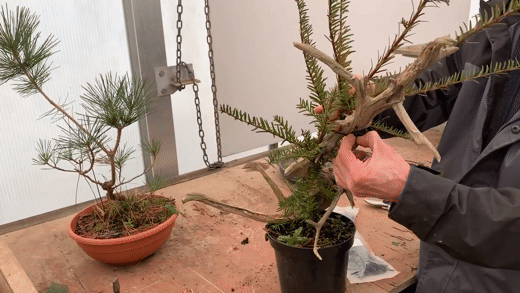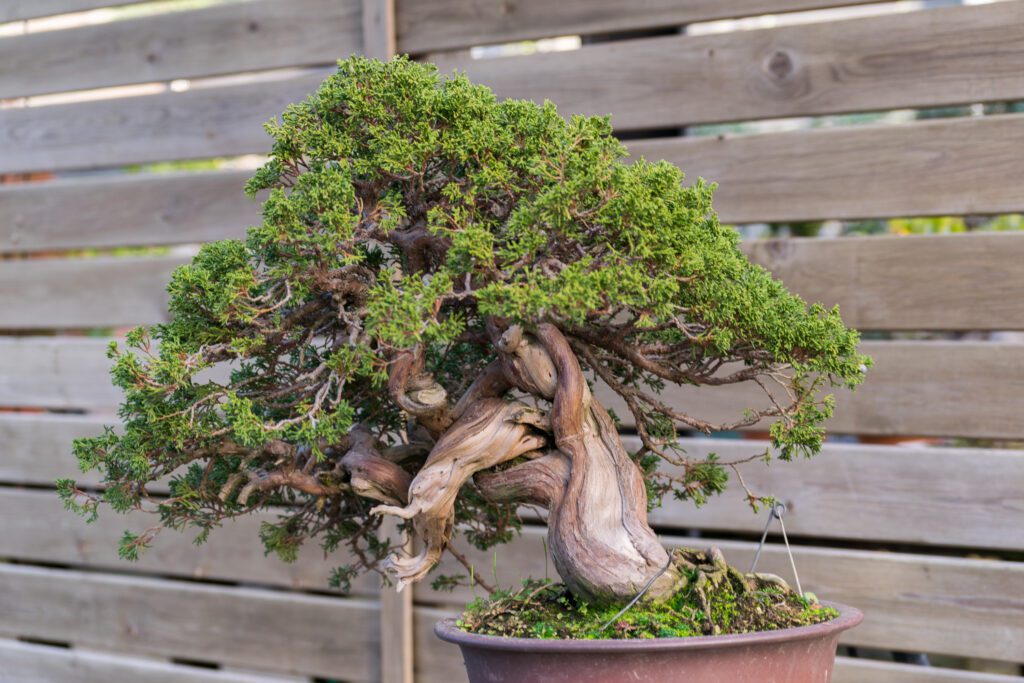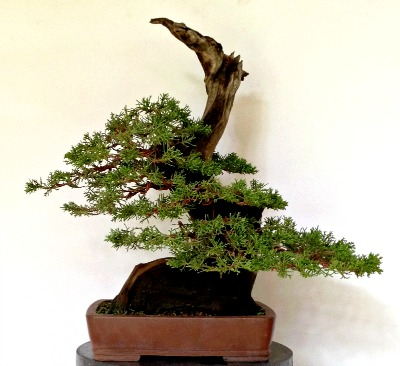Tanuki bonsai is a unique technique for making bonsai look much older than they are.
Many traditional styles can be created by joining a live plant with a piece of dead wood. Other familiar names for Tanuki are deadwood bonsai and phoenix grafting.
Although considered “phony bonsai” in some circles, Tanuki can be impressive when done properly. With some age, you most likely won’t even know that the bonsai was formed via the Tanuki process.
In the United States, artist Dan Robinson is credited with naming this process a “Phoenix Graft.”

What Is Tanuki Bonsai?
Tanuki is the process of creating a single bonsai using two different sources of plant material: a live bonsai paired with deadwood (often a piece of driftwood).



This has frequently been the subject of much debate within western bonsai communities. These creations are called “tanuki” bonsai by the Japanese and “phoenix transplants” by Westerners.
Tanuki is also created in Japan. However, they are not allowed in formal exhibits. Outside the Orient, it is considered respectful to “admit to your deception.” You may even want to brag if it’s a very good subject.

The process of Tanuki is the same regardless of the name used to describe them. The centerpiece of the planting is a large, interesting piece of dead wood. A router bit or die grinder is used to inscribe the groove in the deadwood. Then, a young leggy plant is attached to the groove by nailing, screwing, or any other means. Junipers and other evergreen shrubs are often used for Tanuki.
The young plant will eventually grow into the deadwood, creating a proper Tanuki deadwood bonsai. Once the screws have been removed, the total form is shaped using bonsai techniques.
Real Life Tanuki Example – Deadwood Bonsai

The above tanuki bonsai was displayed at the 2015 Bonsai Societies of Florida convention.

Finding the perfect combination of tree and dead wood is not as easy as you think. Mike Sullivan, a South Florida bonsai artist, created the above tanuki from a small juniper and a piece of buttonwood driftwood. Shown here in 2008, still in the early stages of development.
Tanuki Bonsai – The Early Stages
Although nothing says Juniper Bonsai is the only plant to use, it is the most popular.




Not everyone uses screws and nails. Some use glue. Others tighten the combination of tree and driftwood with ties, string or wire. If this is your choice, be watchful that the bark isn’t damaged by the pressure as the young tree grows.

Tanuki Problems
A tanuki bonsai, due to the fact that it is made from deadwood, is only temporary. It will depend on the wood used to create it, and always remember that water is the enemy.
Deadwood that comes in contact with moisture will eventually rot.



No matter how beautiful the deadwood may be, it will not work. It must be very dense and hard. The deadwood’s upper parts will weather well if they don’t come in direct contact with the soil mass. However, the soil mass can be contaminated with moisture, and the portions that extend into the soil mass will rot quickly if not dense enough.
Some paint it with a wood preserver to prevent moisture from affecting deadwood. Also, ensure that the chemical does not leach into the soil and cause damage to the tree next to it.
A Tanuki Story “Joint Venture”
This combination of driftwood and juniper is a joint venture by David Cutchin and David VanBuskirk, Ocklawaha, Florida. David V.. attached the two, and David C. styled the tree.

Tanuki Name Note: Because these bonsai trees look like something they aren’t, they’re named after a Japanese “racoon dog-badger.” Tanuki is a Japanese name for this, somewhat magical shape-shifting creature! This canine can change looks from fox to raccoon and back to a dog.
Is Tanuki Cheating?
To find “real” trees like these tanuki bonsai in nature, you may have to climb mountains. So, is it cheating? Some say yes. Others just enjoy them for what they are, a creative combination of nature, living and dead.



Other Forms Of Deadwood Bonsai
Jin, also known as Shari, is another way to create the appearance of age on a bonsai. Real “jin” on trees, for example, is created by branches breaking off from strong winds, lightning or heavy snow.
When designing a Bonsai, the branches are not required to be part of the main foliage mass.
They can be used to make Jin. This shows the tree’s age and how it has survived. This is a very advanced style. You must make Jin look natural to consider it a success.
Jin Techniques



You would use hand tools to carve the tree for Jin. To mimic a broken branch, the wood is torn off.
If the tree has more than one trunk, one of them would be removed to make a stump appearance.
The second trunk will dry over time. You will need to remove any bark or soft tissue from the area you are Jin. The stump will be removed above the soil. After you have removed the tree, any other work can be done.
You will first need to remove the wood slithers from the stump. Then, you’ll need to notch or crush the top of the wood with pliers.
Next, use Jin pliers to pull each segment from the stump.
When removing the wood strips, be careful not to damage any live wood at the base and sides. To remove the tissue and wood from the second stump, you must pull it away. This will reveal the tree’s natural form.
The Jin will take shape once the second stump has been completed.



This gives the wood its wonderful texture. You will notice small burrs and pulls in the fibrous wood. You can use a lighter to gently heat the wood.
The stump should now be carefully scorched.
You can prevent the flames from damaging the rest of your tree by placing a piece of hardboard between the stump and the rest. You can also use fine sandpaper for any tool marks. To replicate the natural appearance of the stump, you can round off any sharp edges.
To whiten the Jin and prevent it from rotting, you will use the lime sulfur during process. You can also add black ink to lime sulphur to give the impression of depth.
After this check out our other articles on:
Frequently Asked Questions
What Is A Tanuki Bonsai?
A Tanuki Bonsai is a technique in which a deadwood is attached to a young bonsai tree to create the appearance of an old and weathered tree. This technique is also known as Phoenix Grafting.
How Is A Tanuki Bonsai Created?
A Tanuki Bonsai is created by attaching a piece of driftwood, deadwood, or other suitable material to a young bonsai tree. The tree is then trained and pruned to blend with the attached material. Over time, the roots of the bonsai tree will grow around the deadwood, creating a strong bond.
What Are The Advantages Of Creating A Tanuki Bonsai?
The main advantage of creating a Tanuki Bonsai is that it allows you to quickly create the appearance of an old and mature bonsai tree. It can also be a fun and creative way to express your personal style and create a unique bonsai.
What Are The Disadvantages Of Creating A Tanuki Bonsai?
The main disadvantage of creating a Tanuki Bonsai is that it is considered by some to be a controversial technique as it involves attaching deadwood to a living tree. Additionally, it can be difficult to create a natural-looking and aesthetically pleasing Tanuki Bonsai, especially if the deadwood is not well-matched to the bonsai tree.
How Do I Care For A Tanuki Bonsai?
Caring for a Tanuki Bonsai is similar to caring for any other bonsai tree. It is important to monitor the soil moisture, sunlight, and temperature to ensure that the bonsai tree remains healthy. Additionally, it is important to be gentle when pruning and wiring the bonsai tree as the bond between the tree and deadwood can be fragile.
Can Any Bonsai Tree Be Used For A Tanuki Bonsai?
In theory, any bonsai tree can be used for a Tanuki Bonsai. However, it is important to choose a tree that is compatible with the attached deadwood in terms of size, texture, and style. Additionally, it is important to choose a healthy and strong bonsai tree that is capable of growing around the deadwood.






